Transcription of ESPEN guidelines on nutrition in cancer patients
1 Clinical nutrition xxx (2016) 1e38. Contents lists available at ScienceDirect Clinical nutrition journal homepage: ESPEN Guideline ESPEN guidelines on nutrition in cancer patients *. Jann Arends a, Patrick Bachmann b, Vickie Baracos c, Nicole Barthelemy d, Hartmut Bertz a, Federico Bozzetti e, Ken Fearon f, y, Elisabeth H tterer g, Elizabeth Isenring h, Stein Kaasa i, Zeljko Krznaric j, Barry Laird k, Maria Larsson l, Alessandro Laviano m, Stefan M hlebach n, Maurizio Muscaritoli m, Line Oldervoll i, o, Paula Ravasco p, Tora Solheim q, r, Florian Strasser s, Marian de van der Schueren t, u, Jean-Charles Preiser v, *. a Department of Medicine I, Medical Center e University of Freiburg, Faculty of Medicine, University of Freiburg, Germany b Centre R egional de Lutte Contre le cancer L eon B . erard, Lyon, France c Department of Oncology, University of Alberta, Edmonton, Canada d Centre hospitalier universitaire, Li.
2 Ege, Belgium e University of Milan, Milan, Italy f Western General Hospital, Edinburgh, United Kingdom g Medical University of Vienna, Austria h Bond University, Gold Coast, Australia i Norwegian University of Science and Technology, Trondheim, Norway j University Hospital Center and School of Medicine, Zagreb, Croatia k Beatson West of Scotland cancer Centre, Edinburgh, United Kingdom l Karlstad University, Karlstad, Sweden m University of Rome La Sapienza, Roma, Italy n University of Basel, Basel, Switzerland o The Norwegian Heart and Lung Association (LHL), Oslo, Norway p Faculty of Medicine, University of Lisbon, Lisbon, Portugal q European Palliative Care Research Centre (PRC), Department of cancer Research and Molecular Medicine, Faculty of Medicine, NTNU, Norwegian University of Science and Technology, Norway r cancer Clinic, St.
3 Olavs Hospital, Trondheim University Hospital, Trondheim, Norway s Oncological Palliative Medicine, Clinic Oncology/Hematology, Dept. Internal Medicine and Palliative Center, Cantonal Hospital St. Gallen, Switzerland t VU University Medical Center (VUmc), Amsterdam, Netherlands u HAN University of Applied Sciences, Nijmegen, Netherlands v Erasme University Hospital, Universit e Libre de Bruxelles, Brussels, Belgium a r t i c l e i n f o s u m m a r y Article history: Cancers are among the leading causes of morbidity and mortality worldwide, and the number of new Received 21 July 2016 cases is expected to rise signi cantly over the next decades. At the same time, all types of cancer Accepted 28 July 2016 treatment, such as surgery, radiation therapy, and pharmacological therapies are improving in sophis- tication, precision and in the power to target speci c characteristics of individual cancers.
4 Thus, while Keywords: many cancers may still not be cured they may be converted to chronic diseases. All of these treatments, Guideline however, are impeded or precluded by the frequent development of malnutrition and metabolic de- cancer rangements in cancer patients , induced by the tumor or by its treatment. Cachexia These evidence-based guidelines were developed to translate current best evidence and expert Malnutrition opinion into recommendations for multi-disciplinary teams responsible for identi cation, prevention, Sarcopenia and treatment of reversible elements of malnutrition in adult cancer patients . Anorexia The guidelines were commissioned and nancially supported by ESPEN and by the European Part- Surgery Radiotherapy nership for Action Against cancer (EPAAC), an EU level initiative. Members of the guideline group were Chemotherapy selected by ESPEN to include a range of professions and elds of expertise.
5 *. These guidelines have been of cially endorsed by the European Society of Surgical Oncology (ESSO), the European Association for Palliative care (EAPC) and the Chinese Society of Clinical Oncology (CSCO). * Corresponding author. E-mail address: ( Preiser). y Deceased. 0261-5614/ 2016 European Society for Clinical nutrition and Metabolism. Published by Elsevier Ltd. All rights reserved. Please cite this article in press as: Arends J, et al., ESPEN guidelines on nutrition in cancer patients , Clinical nutrition (2016), 2 J. Arends et al. / Clinical nutrition xxx (2016) 1e38. Hematopoietic stem cell transplantation We searched for meta-analyses, systematic reviews and comparative studies based on clinical ques- Palliative care nutrition assessment tions according to the PICO format. The evidence was evaluated and merged to develop clinical rec- nutrition therapy ommendations using the GRADE method.
6 Due to the de cits in the available evidence, relevant still open Exercise training questions were listed and should be addressed by future studies. Malnutrition and a loss of muscle mass are frequent in cancer patients and have a negative effect on clinical outcome. They may be driven by inadequate food intake, decreased physical activity and catabolic metabolic derangements. To screen for, prevent, assess in detail, monitor and treat malnutrition standard operating procedures, responsibilities and a quality control process should be established at each institution involved in treating cancer patients . All cancer patients should be screened regularly for the risk or the presence of malnutrition. In all patients e with the exception of end of life care e energy and substrate requirements should be met by offering in a step-wise manner nutritional interventions from counseling to parenteral nutrition .
7 How- ever, bene ts and risks of nutritional interventions have to be balanced with special consideration in patients with advanced disease. nutritional care should always be accompanied by exercise training. To counter malnutrition in patients with advanced cancer there are few pharmacological agents and pharmaconutrients with only limited effects. cancer survivors should engage in regular physical activity and adopt a prudent diet. 2016 European Society for Clinical nutrition and Metabolism. Published by Elsevier Ltd. All rights reserved. GL nutrition in cancer patients e Outline Abbreviations used O. Methods AML acute myeloic leukemia O1. Basic information ASCO American Society of Clinical Oncology O2. Methods BCAA branched-chain amino acids O3. Post-publication impact BIA bio impedance analysis BMI body mass index A.
8 Background BMT bone marrow transplantation A1. Catabolic alterations in cancer patients BMR basal metabolic rate A2. Effects on clinical outcome CHT chemotherapy A3. Aims of nutrition therapy CRP C-reactive protein d day B. General concepts of treatment relevant to all cancer patients DEXA dual-energy x-ray absorptiometry B1. Screening and assessment DHA 22:6 docosahexaenoic acid B2. Energy and substrate requirements ECOG Eastern Cooperative Oncology Group B3. nutrition interventions EAPC European Association for Palliative Care B4. Exercise training EFSA European Food Safety Authority EN enteral nutrition B5. Pharmaconutrients and pharmacological agents EPA 20:5 eicosapentaenoic acid C. Interventions relevant to speci c patient categories ERAS enhanced recovery after surgery C1. Surgery ESMO European Society for Medical Oncology C2.
9 Radiotherapy FDA Food and Drug Agency GI gastrointestinal C3. Curative or palliative anticancer drug treatment GL guideline C4. High-dose chemotherapy and hematopoietic stem cell GPS Glasgow Prognostic Score transplantation (HCT) GvHD graft versus host disease C5. cancer survivors HCT hematopoietic stem cell transplantation C6. patients with advanced cancer receiving no anticancer HMB -hydroxy methyl butyrate HTA 16:4 hexadecatetraenoic acid treatment IGF-I insulin-like growth factor I. Appendix A. Supplementary data: Evidence tables ISOO International Society of Oral Oncology References LOS length of hospital stay (days). MA megestrol acetate MASCC Multinational Association of Supportive Care in cancer mGPS modi ed Glasgow Prognostic Score MNA mini nutritional assessment MNI Medical nutrition International MST Malnutrition Screening Tool MUST Malnutrition Universal Screening Tool NSAID non-steroidal anti-in ammatory drugs Chapter O: Methods NSCLC non-small cell lung cancer ONS oral nutritional supplements O1.
10 Basic information N-3 fatty acids polyunsaturated fatty acids of the N-3 or omega-3 series PAL physical activity level 1. Terms and abbreviations PEG percutaneous endoscopic gastrostomy PG-SGA patient-generated Subjective Global assessment A cancer patient is a patient with a cancer diagnosis who is PICO populations of interest, interventions, comparisons, outcomes either waiting for or on cancer directed treatment, on symptomatic PN parenteral nutrition treatment, and/or receiving palliative care. QoL quality of life patients cured from their cancer are termed cancer survivors . RCT randomized controlled trial REE resting energy expenditure Pharmaconutrients are nutrients supplied in pharmacolog- RT radiotherapy ical doses to modulate immune and metabolic functions and exert SARM selective androgen receptor modulator effects on clinical outcome.











